Technology
Perovskite: Promising Light-emitting Material
Perovskite, specifically metal halide perovskites, characterized by it's unique ABX₃ crystal structure—where A is a organic ammonium cation (MA+,FA+) or inorganic alkali cation (Cs+), B is a transition metal cation (Pb2+, Sn2+, Cu2+), and X is an halide anion(Cl-, Br-, I-)—are emerging as revolutionary candidates for next-generation light-emitters, particularly in Perovskite LEDs (PeLEDs), and Perovskite Color Conversion Layer for integration with LCD, OLED, and inorganic LEDs. Perovskites offer high luminescence efficiency, excellent color purity, and low-cost solution processability, positioning them as strong contenders to replace traditional OLEDs and QLEDs.
Perovskites feature narrow emission spectra for vivid colors, high photoluminescence quantum yield, and tunable optical properties that allow for precise control over emission wavelengths, including red, green, and blue. In addition to these characteristics, they also offer the advantages of low manufacturing costs and compatibility with flexible substrates. Therefore, perovskite light-emitters are ideal materials for advanced display and high-efficiency lighting production, placing them at the forefront of future display and lighting technologies. SN Display is actively working to bring perovskite light-emitter to market, with our exclusive technologies and expertise.
Realizing commercially viable luminescence efficiency through nano-crystallization of perovskite
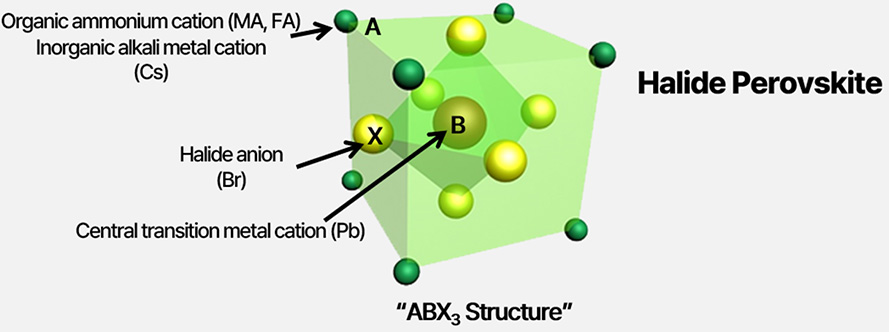

*Exciton confinement effect: The excitons (electron and hole pairs) are better confined in nanocrystals than bulk crystals for radiative recombination
Beyond Bulk: From Bulk Particles to Nanocrystals
Our journey began with a transformative leap from conventional Perovskite Bulk to Perovskite Nanocrystals (PeNCs), marking the creation of the first LED based on this revolutionary material, patented in 2014. While traditional Bulk Perovskite demonstrated promising luminescence properties at low temperatures, its performance at room temperature was critically limited, a challenge that was left unsolved for decades.
However, we overcame this obstacle by downsizing the material to nanometer scale, significantly enhancing its room-temperature electroluminescence efficiency to levels comparable to with conventional OLEDs. This remarkable efficiency boost is driven by the exciton confinement effect, which facilitates efficient exciton recombination by increasing exciton binding energy, which can prevent thermal dissociation of excitons at room temperature and thereby enhancing radiative emission. This innovation laid the foundation for a new era in display technology, with the exceptional optoelectronic properties of PeNCs such as superior brightness, high absorption, and excellent color purity.
Beyond Quantum: Surpassing Inorganic
Quantum Dots with Perovskite Nanocrystals
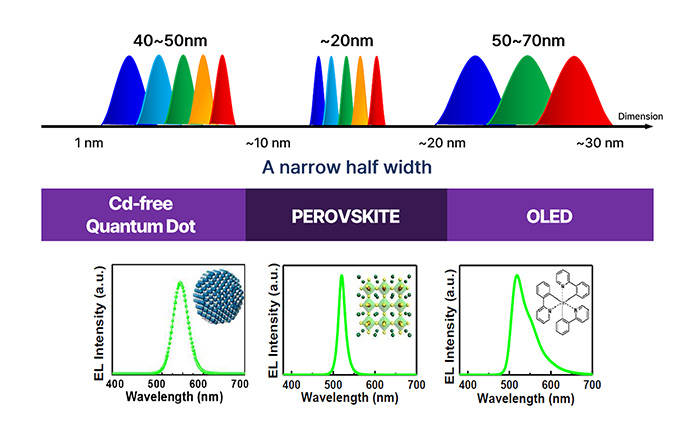
Inorganic Quantum Dots (QDs) have received spotlights because of their applications in Samsung QD-OLED and the 2023 Nobel Prize in Chemistry. The main advantage of this material is the ability to control the properties of the semiconductor by adjusting the size within the quantum confinement region, which is typically below the exciton Bohr diameter (generally less than 10 nm). The quantum confinement effect allows tuning of the emission wavelength by adjusting the bandgap of the particles based on their size. For example, smaller particles emit shorter, blue-shifted wavelengths. However, if the QD size becomes too small, the surface may be incompletely passivated, which can lead to reduced luminescence efficiency or decreased light absorption. This poses a critical limitation for photoluminescence applications, particularly for color conversion layers for the high-resolution or small area displays.
Color Conversion Layer (CCL) Prototypes by SN Display
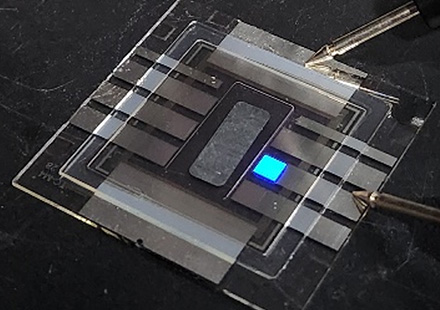
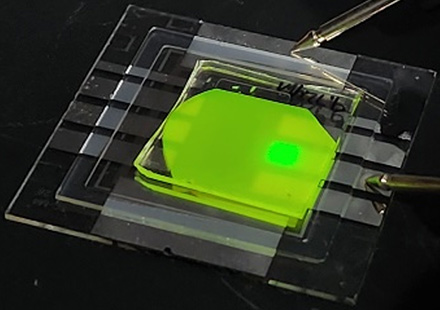
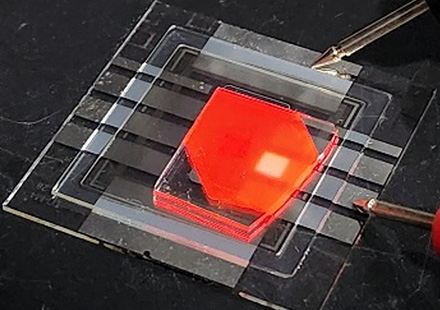
In QD-OLED display structures, for instance, inefficient light absorption in QD-based color conversion layers can lead to blue light leakage, thicker color-conversion layer, and reduced overall power efficiency. Compared to QDs, PeNCs exhibit excellent luminescence properties beyond the quantum confinement region, so the particle size can be larger than exciton Bohr diameter. Unlike QDs, which require precise size control during synthesis, PeNCs can easily tune the emission wavelength by adjusting their composition, reducing production costs and maintaining the consistent product quality. Our PeNCs, with high absorption and high luminescence efficiency, enable optimal color conversion in thinner layers, resulting in enhanced performance across a wide range of displays, from large TVs to ultra-small AR/VR displays.
Beyond Instability: Achieving Superior Stability
with New Core-Shell Structures
While perovskite materials have shown great potential, their stability has been a key challenge. To address this, we developed a new core-shell structure that dramatically enhances the stability of Perovskite Nanocrystals, making them suitable for real-world, commercial applications. Our novel approach mitigates the issues of material degradation and environmental sensitivity, ensuring that displays maintain their high performance over extended periods and under varying conditions. This breakthrough represents a significant step forward, enabling the reliable integration of perovskite materials into high-performance display devices.
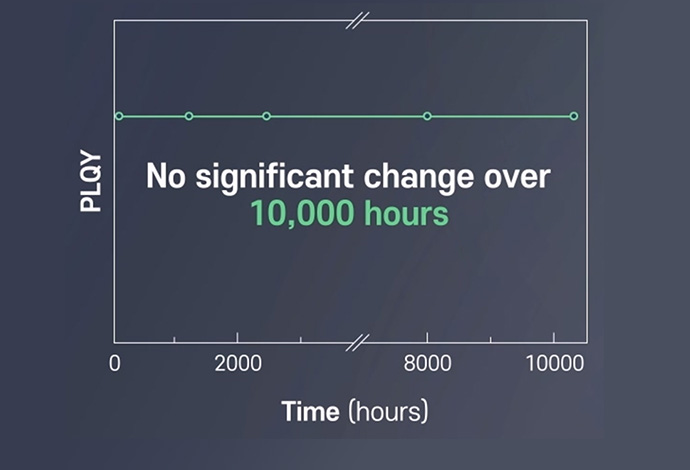
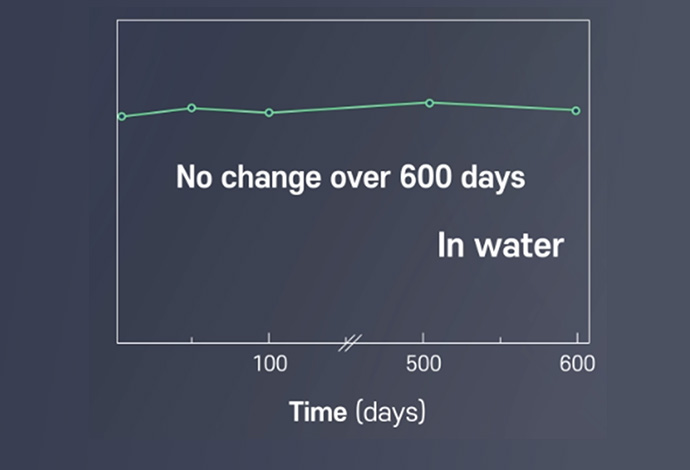
In 2022, we published a paper in Nature on an electroluminescence device fabricated using an in-situ core-shell strategy, which achieved record external quantum efficiency (28.9%), remarkable brightness of ~473,000 cd/m²), and long device lifetime of T50~31,000 hours —an almost thousand-fold enhancement over previous lifetime record in the field. Currently, we are also obtaining impressive results in our research on color conversion layer applications, demonstrating extreme stability with a lifetime (T90 > 15,000 hours, testing ongoing) under direct blue light illumination. Additionally, we are achieving commercially-viable results on the par with inorganic QD performance under harsh conditions, such as high temperatures (≥ 60°C) and high humidity (≥ 90% RH), and high Flux (≥100 mW/cm2), while maintaining its high optical properties (PLQY ≥ 90%). With further improvement in pixel resolution, our product is ready for commercialization in small displays, including premium AR/VR, cell phone, smart watch and more.
